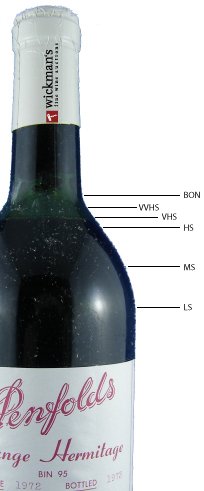At Wickman's we inspect each bottle (except for unopened cartons) and
attempt to describe them accurately for the auction listing.
You can infer a lot
about the treatment of a bottle of wine from its description and you should always exercise
caution when purchasing wine of unknown provenance.
Label Condition
The condition of the front label can affect the price of a bottle and can also give clues as to the
environment the bottle was exposed
too. Most of the time, if you are interested in the contents of the bottle and
not its cosmetic condition, it should not affect your decision to
buy unless there are contra-indicators (weeping, low level etc.) that may point to poor storage
conditions.
Note: Back labels are rarely described.
Soiled Label
Often describes a label that may have been stored in an underground passive
cellar that has been soiled over time by dust, mould or dirt.
Stained Label
Describes a label that has been stained by liquid. Often damp, passive cellars
can create these stains as well as wine stains caused, as sometimes occurs, by a
spillage of wine. Usually cosmetic and ultimately innocent when observed without
any signs of weeping.
Cellar Scuffed or Worn Label
Often these bottles show some signs of wear after they have been repeatedly
removed from racks in a cellar or wine fridge.
Capsule and Seal Condition
The capsule is the protective sleeve covering the neck of the bottle and can be made of foil, plastic, tin, aluminium and in some older bottles lead.
Cracked wax
Sealing wax is sometimes used to cover the capsules. This is not ordinary wax by the way, dont try to seal your bottle at home. In large format bottles such as magnums and imperials, the volume of the bottle and movement can often crack the wax. This does not indicate any fault or problem with storage and can often happen when the bottle is moved.
Ullage or Level
Ullage is a term that refers to the fill level in a bottle, the space between
the bottom of the cork and the wine when the bottle is standing upright. It is
normal for some loss to occur from the bottle over time but it can also indicate
a degree of risk with drinking the wine due to easing of the cork or exposure to
detrimental environmental conditions.
It is not an exact science and the images and descriptions below should be used
as a rule of thumb and guideline only when you are trying to determine the level
of risk involved with buying mature wine through the wine auction system.
Note: The following descriptions apply to 750ml
bottles only as Magnums and larger formats are often hand filled and this
can result in an under filled container and will not necessarily indicate a
problem.

BON = Base of Neck. Good for
any age and excellent for any bottle 10 years or older (ie
2015 & older).
VVHS = Very, Very High Shoulder. Normal for any bottle older
than 15 years (ie
2010
+) and
very good for bottles 35 years+ (ie.
1990 & older).
VHS = Very High Shoulder. A good level for any wine 15+ years
and older (2010 & older).
HS = High Shoulder. This is considered a normal level for wines
20 years or older (ie
2005 & older).
MS = Mid-Shoulder. This level suggests that some natural
reduction through the easing of the cork and evaporation has occurred and is
usual for bottles 50 years or older (ie
1975 & older). This is a high risk category and should be
valued accordingly if you are planning to drink this wine as opposed to
obtaining it as a collectible.
LS = Low Shoulder. A highly risky proposition for any age and values should be
significantly lower to account for the risk.
Author: Mark Wickman
wineauction@wickman.net.au
Google+
Copyright ©2015 Mark Wickman, All Rights Reserved.